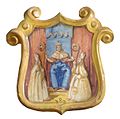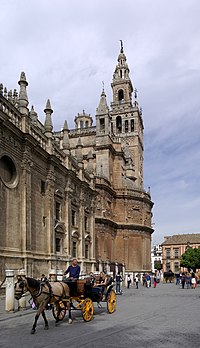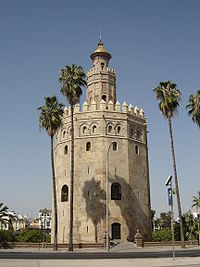| Seville Sevilla | |
 Seville's bullfight arena Seville's bullfight arena | |
| Arms | |
 | |
| Information | |
| Country | Spain |
| Region | Andalusia |
| Surface | 141.31 km² |
| Population | 704 414 |
| website | |
Seville (Spanish Sevilla) - a large, historic city in the south Spain, capital and main city Andalusia, the administrative center of the province of Seville. It is located on the Guadalquivir River and has a navigable connection with the Atlantic Ocean. Seville is considered the capital city flamenco.
General Information Nothing has beeeeeeeeeeeeeeeeeeeeee
vggggg Drive
By plane
| This section contains information as of January 2014 |
Seville San Pablo Airport (Aeropuerto de Sevilla-San PabloIATA: SVQ, ICAO: LEZL) is located 25 minutes (10 kilometers) from the center of Seville. Buses run approximately every 30 minutes and that's how long it takes. The ticket price is approximately € 4. Taxi approx. € 22 a day, and after 10pm and weekends / holidays, expect a higher fee.
By car
By rail
The largest train station is Sevilla Santa Justa. Railway connections: Madrid, Cadiz, Barcelona. Travel time by AVE train to Madrid is approximately 2 hours and 30 minutes.
By bus
Communication
Seville is a well-connected city, a one-way ticket costs 1.20 euros. We buy it from the driver at the entrance. You can also stock up on tarjeta de 10 viajes, i.e. a ticket for 10 journeys, it costs 5 euros or tarjeta de 10 viajes con transbordo i.e. a ticket for 10 journeys with a change, costs 6 euros, but you have to buy it in an estanco or a special ticket shop, where you can also get a map of Seville for free with day and night public transport marked.
To get from the airport to the city center, take the only bus that leaves the airport. Its last stop is Prado San Sebastian.
From Santa Justa Estacion, to get to Plaza Encarnacion, for example, take bus number 32 to the end. Plaza Encarnacion is one of the 2 main bus hubs.
The second such bus node is San Sebastian Prado (in the city center) near the Realez Alcazares and Plaza Espana and Avenida Constitucion. From there, you can get to the UPO (Universidad Pablo de Olavide) and the Reina Mercedes and Triana districts.
Night transport: from Monday to Friday, there are 6 night buses running every hour until 2.00, on Saturdays and Sundays every hour until morning (i.e. until the day buses). The prices for night buses are the same as for day buses, i.e. 1.2 euro for one trip.
Worth seeing





- Alcazar (Reales Alcazares) - royal palace with magnificent gardens, admission costs 9.5 euro, children up to 16 years of age, the elderly over 65 and students do not pay admission, you need to show your ID cards
- Cathedral of the Virgin Mary- the third largest cathedral in the world, with the magnificent Giralda bell tower (formerly minaret), 97 m high, integrated into the body of the church, you can enter it for a fee of about 7 euros, students, children up to 16 years of age and the elderly entry costs 2 euros. Inside, there are chapels - Capilla Mayor and Capilla Real, a choir and Columbus tomb.
- Town hall - a magnificent Renaissance building built on the former tournament square in the years 1527-64.
- stock market - Renaissance building of the commercial exchange, from 1583-98. In the 18th century, Charles III placed the Central Archives of India here, collecting documents related to the discovery and conquest of the New World.
- Torre del Oro (Golden Tower) from the 13th century, one of 166 in the Moorish defense system, later rebuilt. It owes its name not only to the then cladding with golden azulejos tiles, but also to the fact that it was used for storing gold from the colonies. It was also important from a defensive point of view, since between it and the twin, no longer existing, tower on the other side of the Guadalquivir, a chain could be opened that blocked the entrance to the port. It currently houses the Maritime Museum (Museo Maritimo) devoted to monuments and nautical maps.
- Main Archive of India - typed on UNESCO list an archive containing documentation of Spain's overseas possessions.
- Bullfighting arena (La Plaza de Toros de la Real Maestranza de Caballería de Sevilla), an amphitheater built in 1749-1881, seating 12,500 spectators. Inside is a bullfight museum displaying a collection of costumes (including a purple toreador's purple cope painted by Picasso), portraits and posters.
- 'Hospital of Mercy (Hospital de la Caridad), a hospital founded in the 17th century by Miguel de Maňar. The hospital was built on the premises of the Royal Shipyard. A baroque church was also built next to the hospital, which houses a rich collection of Spanish paintings.
- House of Pilate (Casa de Pilatos), A 15th-century palace built on the model of Pilate's house. Its construction was started in 1492 by Pedro Enriquez, the royal governor whose wife was Catalina de Ribera. The construction was completed by his son Fadrique, the first Marquis de Tarifa. After his pilgrimage to Jerusalem in 1512-1519, he stated that the distance from the palace to the Cruz del Campo church was the same as from Pilate's house to Golgotha. So he ordered the Stations of the Cross to be placed between the palace (first station) and the church (last station).
- Spanish Square (Plaza de España), built in the 1920s on the basis of a design by Seville architect Aníbal Gonzáles, a semicircular square enclosed by a palace on one side, the central façade of which was built in the Baroque style, while the rest of the building in the Renaissance style. Additionally, two corner towers modeled on the Giralda were built.
work
Science
The education system in Spain is as follows: first 6 years in primary school, then 4 years in the next compulsory school, and then you can go to 2-year lower secondary school, where education ends with the matriculation examination. When it comes to studies, they also have undergraduate and graduate studies in Poland. The leading university in Seville is Universidad de Sevilla, located throughout the city (depending on the faculty). Universidad de Pablo Olavide is a new university, located outside the city, about 30 minutes from the center by bus. Note: it can only be reached from Seville by one bus number 36 (!)
Shopping
From Seville, it is worth bringing the commemorative glaze available in many souvenir shops, because it is an original thing, fans. Of these typical purchases, groceries are best done in inexpensive supermarkets: SuperSol, Mas, Dia%. Shopping for clothes is cheaper. Interesting shops are Lethies and Zara (and they are cheaper than elsewhere), H&M has the same prices as in Poland. I recommend the Corte Ingles department store to those who can afford expensive shopping.
Gastronomy
Parties
Accommodation
Accommodation prices depend on how far from the center we want to stay. Hotel prices are from about 150 euro per night including breakfast, hostel prices are about 20 euro per night, but you should take into account that if we do not book accommodation in advance, there will be no places. From hostels I recommend Oasis Sevilla not expensive, it is located in Plaza Encarnacion, it is easy to get there from the airport and the center is 5 minutes on foot [1].
contact
Security
Macarena is definitely one of the dangerous neighborhoods, and recently also Nervion, you have to keep an eye on backpacks and handbags in Plaza Salvadore and in all smaller streets, apart from these areas, Seville is quite safe even after dark.
Tourist information
In the city center there are several tourist information where we can get a map of Seville for free, but not all of them speak English.
Where next
| This is outline article. For now, it includes the article schema and not much else. You can help by supplementing the article with at least basic information, making it useful. |

